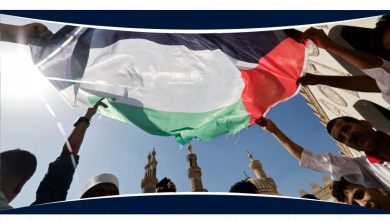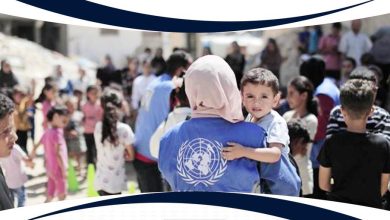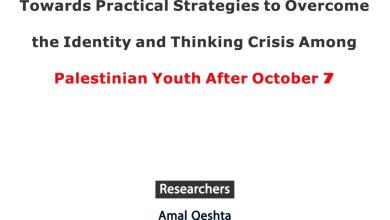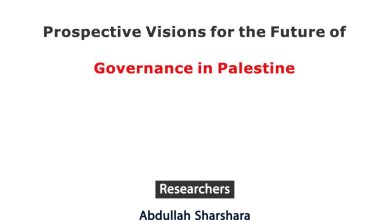UNRWA’s Educational System and Impact
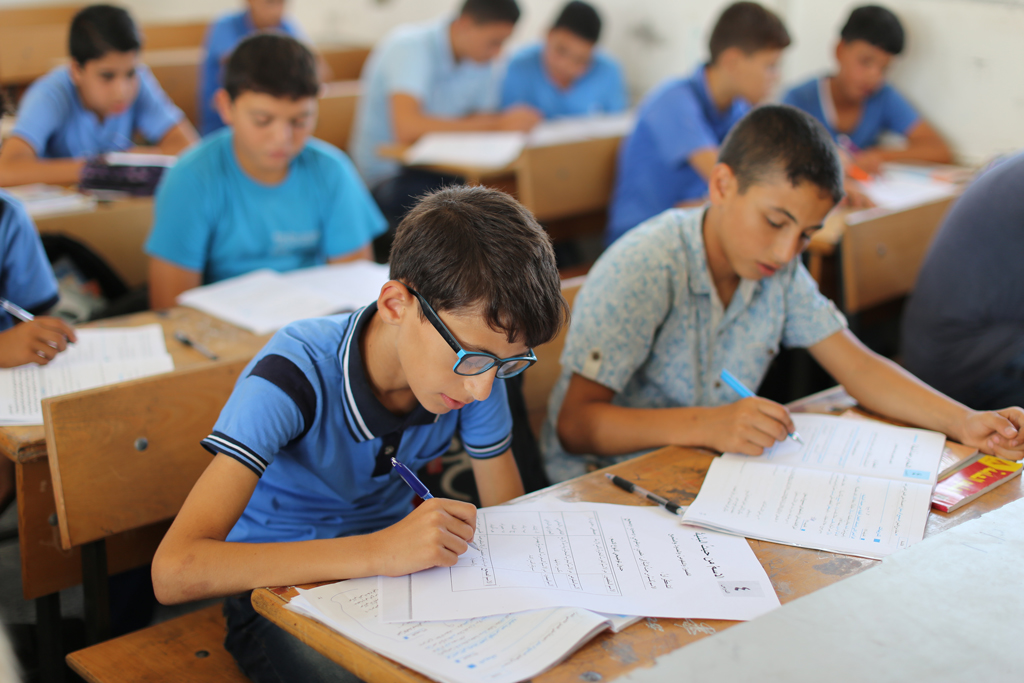
By John Mark Shorack *
October 2018
The United States government under President Trump recently announced the withdrawal of monetary aid to the United Nations Relief and Works Agency, commonly referred to as UNRWA. This is a major blow to UNRWA’s finances considering the United States’ yearly contribution’s amounted to one-third of their budget. Since UNRWA’s founding it has been a leading force providing support of Palestinian refugees across the Middle East region mainly providing education and emergency medical assistance.
This recent decision by the United States government combined with President Trump’s recent handling of Israel-Palestinian relations has once again brought the conversation of Palestine, Palestinian refugees, and the conflict to the forefront of the conversation, and rightfully so. To positively engage these issues, it’s crucial to understand UNRWA’s history, assess how its focus has shifted and show what it has accomplished since its founding, and that is what follows.
UNRWA was created by the United Nations after the war of 1948, referred to as Al-Nakba (The Catastrophe) by the Palestinians or by Israel as their war of independence. During the war, a group of about 750 thousand Palestinians were forced to disperse from the land which became the nation of Israel, either by choice, fear or persecution.[1] UNRWA, created to support these refugees who fled, was meant as a temporary institution, however, its mandate has been continually renewed by the United Nations mainly because no adequate solution has been found for the land or for the situation of the refugees living in the surrounding areas and countries.
This research presents the historical transformation of UNRWA meant for short term emergency assistance to an institution that provides a crucial education service. It reveals how the conditions of refugees in their host countries comparatively affect their education.
UNRWA’s Development as an Institution
On December 8th, 1949 the General Assembly of the United Nations under Resolution 302 established UNRWA to provide “direct relief and works programmes” for the refugees until 1950 or until an agreed upon date [2]. Its purpose was to create projects alongside local governments for the refugees to have employment. As the years continued and nothing changed the relief works programs were no longer an effective long-term solution and in the 1960’s UNRWA shifted its focus towards education for the children of refugees.
As UNRWA shifted, its budget reflected this transition. In the 1958 annual budget, general education received five million of forty million total dollars budgeted, about one eighth of the budget.[3] Two years later it increased to one fourth of the budget an upward trend which is maintained till now.[4] In the 1979 annual report, they made the transition explicit, “whereas in the early years the greater part of the agency’s resources was to relief services, now it is devoted to education” and therefore 55% of its budget was devoted to education.[5] In the 2013 annual report, education is 60% of the budget,[6] similarly to in 2017, at 57%.[7] Now, education is the main component of their budget and goals as an organization, but they continue to provide emergency medical assistance, award small loans, and have a well-established social safety net program as well.
Maya Rosenfeld, professor of Political Science describes in the Oxford Journals the UNRWA schooling system as the “universalization of nine years of schooling,”[8] exemplifying the priority given to a good education by UNRWA, also seen through the dramatic increase of students attending and the increasing number of students continuing to study. In 1958, one-hundred thousand students went to UNRWA schools, by the year 2000 three-hundred-thousand students were registered.[9] Now, in 2018 they are providing school to more than five-hundred-fifteen thousand children, only possible due to their continued investment in education since the 1960s.[10] Significantly, more of their students are also continuing to study in preparatory school. From 1958, when only 11.1% and 43.9% of boys and girls respectively continued studying,[11] in 2005, 99.3% continued.[12] UNRWA invested more time and money into the education program and the people responded positively. Many of the students from UNRWA schools, also continued onto the university and went to work for the Gulf countries in the early years of the program. This came to an end during the Gulf war.[13] Now many times the post-graduation life can lead to frustration if they cannot find a job.
To better grasp the impact of the education, in the following section, the situation of the refugees and their UNRWA education in each field of operation will be broken down and compared.
UNRWA’s Education System across Fields of Operation
Lebanon
In Lebanon, there are about 449 thousand registered Palestinian refugees in UNRWA offices[14] and they are not granted citizenship or naturalization in Lebanon. They are considered foreigners and with that have many restrictions.
In terms of their residency and mobility, refugees wishing to leave Lebanon since 1995 are required to “’obtain an exit and return visa from the Surete Generale’” and pay the necessary fees; severely limiting the movement of the refugees that live in Lebanon.[15] For refugees within the camps, to change domicile a special permit from the authorities is also required.[16] In terms of employment they are not allowed to practice most professions including, “law, medicine, pharmacy and engineering”.[17] Furthermore, for most jobs a work permit is required which are almost impossible to acquire for a Palestinian.[18] The jobs that do not require a permit are “seasonal workers” mostly in agriculture and the “casual labour in retail enterprises.”[19] However, these jobs are not stable nor very well paid positions.
The refugees in Lebanon have been some of the poorest refugees across UNRWA’s fields of operation. In 1997, 11% of the registered Refugees were a Severe Hardship Case, not able to sustain themselves and relying solely on UNRWA[20] and in 2010, 66% were in poverty and 6.6% in extreme poverty.[21]
In terms of education, the public Lebanese schools are not available to the Palestinian refugees, and the private schools are way too expensive for most.[22] Consequently, most refugee children depend highly on UNRWA for education. As of 2018, they have 69 schools with about 32,350 students.[23] The UNRWA schools, not only have a lot of students they also have a high ratio of 31 pupils to each teacher, whereas, Lebanese schools have 9 pupils per teacher.[24] The pupil to teacher ratio has a huge effect on the quality of education and the personal attention each student receives. One area in which they are identical is the curriculum, since UNRWA uses the host countries’ curriculum to instruct their students.
In 2010, 94.7% of registered children attended elementary school, and 83.3% preparatory school.[25] Unfortunately, the enrollment rate for secondary school is quite lower at 51%, largely because passing a Lebanese government exam is required.[26] UNRWA, due to the inaccessibility of Lebanese schools has created six secondary schools only in Lebanon, where after passing the test, students can continue their education.[27] But, during secondary is also when many refugee children need to start looking for work or a way to sustain themselves derailing their secondary education. These challenges and conditions are major obstacles in their education.
As evidenced by the high enrollment of children up till the end of preparatory school, education matters to the refugees and it gives them hope of a better future. However, there is a large dropout rate into secondary school. Unfortunately, graduating from a school in Lebanon is juxtaposed with the reality which is that you still cannot work and your movement is restricted.
Gaza Strip
Control over the Gaza Strip has shifted throughout history, and even more after the War of 1948 as they reviewed thousands of refugees fleeing. Because of this, UNRWA’s position in Gaza is also shifting along with the power dynamics. At first, the Egyptian curriculum was used once each textbook within it was approved by Israeli and UNRWA officials. Since the Oslo Accords in 1993 they use a “dedicated human rights curriculum.”[28]
In Gaza, most refugee children rely heavily, if not completely, on UNRWA schools for their education. The enrollment rate of students for the 2004-05 school year in Gaza was of 82% in the elementary level and of 78% in the preparatory level.[29] They have 267 schools and almost 12,500 staff,[30] making it the field of operation with the most schools.[31] In Gaza, 71% of the schools work double shifts as of 2013 and “class size was maintained at 38 students.”[32]
There are still some refugees who do not go to UNRWA schools. In a questionnaire from 2007, 49% of the respondents who had not been to school said it was because of the “lack of availability of UNRWA school facilities”[33] and 14% said it was because of “lack of available transportation.”[34] Similarly to in Lebanon, mobility is an impediment to children going to school.
In the 2005-06 school year 0.4% of students in elementary and 2.5% in preparatory dropped out.[35] When children decide to drop out, some of the leading reasons are: to seek work to help the family, no interest in school or another is marriage, among others. Specifically, it points to 20% of students who dropped out “had to work to contribute to the household income.”[36]
In Gaza, there are a number of universities, a good incentive for students to not drop out and instead continue on to higher education.
West Bank
The conditions in the West Bank, similarly to Gaza, are very transitory, at one point it was in the hands of Jordan, then Israel controlled it, and now it is a combination of the Palestine Liberation Organization (PLO) and an Israeli occupation afforded complete control and access. The occupation not only causes psychological and physical harm as it oppresses the Palestinians, the settlements alongside the military checkpoints also humiliate and cause indescribable difficulties and inequality to those living in the West Bank. In 2014, there were four hundred checkpoints in the West Bank,[37] restricting about 50% of the West Bank from easily accessing other areas.[38] Its effect is described by UNRWA as follows:
“Israeli Military incursions and numerous restrictions on mobility (including curfews, closures, and the construction of the barrier in the West Bank) have complicated and/or prevented access of children and teachers to schools, leading to thousands of teaching days lost and to damage to school facilities.”[39]
In effect, all the settlements, barriers and checkpoints are locking the Palestinians in place and restricting their movement to see family, go to school or go to work.
In the West Bank, UNRWA’s school enrollment in the 2004-05 year was 41% in elementary and 38% in preparatory[40] with a ratio of 33 students per teacher, about average for all UNRWA schools and even for the local non-UNRWA schools in the West Bank[41]. Although seemingly few appear to go to school it is because about half of them go to local ran schools in the West Bank. Here is where the highest rate of refugee children attend local schools.
Regarding transportation, most students arrive at school in 10 to 30 minutes from their place of residence,[42] and, the most common method of transportation for 82% of the students who live in the refugee camps and 79% of students who live outside of the camps is walking.[43]
One measure of success for the UNRWA schools is student completion rate of the basic education cycle. In the West Bank it was 62% of students.[44] Additionally, 13% of the students from the West Bank received a university certificate. The dropout rate from preparatory school has decreased for male and female students.[45] In the 1994-95 school year male and female student dropout was of 9% and 5.8% respectively, and by the 2005-06 school year it was of 3.17% and 1.6% respectively.[46] As years passed UNRWA was able to increase student retention and students received a solid education foundation.
Jordan
After the 1948 war, Jordan received many fleeing Palestinians. Unlike other countries, Jordan gave these refugees citizenship and provided them with full rights.
Understanding the UNRWA education in Jordan is challenging because not all refugees live in refugee camps and many refugees go to Jordanian schools. In 2007, 34% of children were enrolled in elementary school and 43% in preparatory.[47] But, even with these low enrollment rates, in 2016 they had around one-hundred-twenty thousand students[48] and 177 schools, second only to the Gaza field of operation.[49]
Although the enrollment rate appears low many do rely on the UNRWA schools, as seen by the high number of schools and pupils attending. In Jordan, after secondary, about 22% have continued to higher education.[50]
Currently, many refugees are trying to leave Gaza and Syria to go to Jordan. This phenomenon has increased the population of refugees in Jordan, however, these new refugees are not granted the same status as the 1948 refugees so there is a split amongst them. Therefore, UNRWA education is becoming even more important in the region for the new arrivals.
UNRWA and Higher Education
After UNRWA schooling how many continue studying? The percentage of students who went to higher education and the comparative dropout rates will be clarified next.
Across the four fields of UNRWA, the Gaza Strip has the largest population of students continuing to study into high school and higher education with 42%, following them are Jordan with 37%, the West Bank 30% and Lebanon 19%.[51] The host areas where refugees were welcomed and encouraged to achieve higher education, did so. To study higher education the local schools are the only option, therefore, the refugee students are limited when these are not available to them.
Lebanon is the field of operation with the lowest continuing rate and the highest dropout rate from elementary school at 14%. Following them is Jordan with 10%, the West Bank 9%, and the Gaza Strip 8%.[52] In Gaza and Lebanon, there is a large percentage of refugee children studying in UNRWA schools, however, Gaza has double the number of students (42%) going into higher education or high school, on the other hand, Lebanon has half (19%). Clearly, the availability of universities in Gaza and the local environment has positively affected the continuation rate.
Conclusion
The United Nations Relief Works Agency began in 1948 by resolution of the United Nations General Assembly supporting the refugees from the 1948 war. At first the agency focused its resources on job creation and income support. As time went on and the refugee crisis continued unresolved the institution shifted focus towards the next generation of refugees. By 1979, a majority of UNRWA’s budget was focused on education as it has continued to do till now. The budgetary shift of UNRWA is at the core of its historical development as an institution.
This article covers a limited scope of fields of operations as well as of programs of UNRWA as an institution and focuses solely on its educational efforts with children, not its effects through health care, microfinancing among other programs. Nonetheless, it provides a view into UNRWA’s main support program and main fields of operation. Across all fields of operations, the UNRWA education system uses different curriculum and has different rates of graduation, however, in all areas it is a vital source of education. The data on students going to school and continuing into higher education shows the refugees determination to learn and how the treatment of refugees affect their studies, as well as their future endeavors and decisions after school.
Finally, UNRWA is an ongoing institution and project, therefore, its action and funding are still being decided upon. Understanding its history, effects and challenges in its fields of operations is never more crucial than now. Although debates on the purpose and effects of UNRWA on a macroscale will continue it is undoubtingly clear that UNRWA provides vital education services to many children who otherwise would be unable to study. Cutting funding and hoping to dismantle UNRWA is part of a larger strategy of the United States, as explained by Rashid Khalidi “of knocking out the pillars that had formerly been assumed to be absolutely essential for any approach to peace in Palestine—refugees, Jerusalem, recognition of Palestinian self-determination.”[53] The United States may have decided to cut its funding, but Germany, among other European countries, have stepped in and have recently decided to contribute more funding validating the importance of the program from an international perspective.
Bibliography
Al Husseini, Jalal. “Education Profile of the Palestine Refugees in the Near East.” UNRWA-NEP Thematic Report, 2007. Accessed November 20, 2014. http://www.academia.edu/5888993/The_Education_profile_of_the_Palestine_refugees_in_the_Near_East.
Al-Natour, Souhiel “The Legal Status of Palestinians in Lebanon.” Journal of Refugee Studies 10, no. 3 (1997): 360-77. Accessed November 8, 2014. Oxford Journals.
“Annual Operational Report 2017.” New York: United Nations, Published: 2018. Web. Accessed on: 05 Oct. 2018.
“Annual Report of the Director of the United Nations Relief and Works Agency for Palestine Refugees in the Near East.” New York: United Nations, 1958. Web. 29 Nov. 2014.
“Annual Report of the Director of the United Nations Relief and Works Agency for Palestine Refugees in the Near East.” New York: United Nations, 1960. Web. 1 Dec. 2014.
Besson, Yves. “UNRWA and Its Role in Lebanon.” Journal of Refugee Studies 10, no. 3 (1997): 335-48. Accessed November 8, 2014. Oxford Journals.
Chaaban, Jad, and Hala Ghattas. “Socio-Economic Survey of Palestinian Refugees in Lebanon.” 2010.
“Gaza Strip” United Nations Relief and Works Agency. 31 October 2016. Web. 06 October 2018.
“General Assembly Resolution 302.” United Nations Relief and Works Agency. December 8, 1949. Accessed October 5, 2018. http://www.unrwa.org/content/general-assembly-resolution-302.
“Jordan” United Nations Relief and Works Agency. 01 Dec 2016. Web. Accessed: 06 Oct 2018
Khalidi, Rashid. The Iron Cage: The Story of the Palestinian Struggle for Statehood. Boston: Beacon Press, 2006.
Khalidi, Rashid. “Rashid Khalidi: From Iran to Palestine, Nikki Haley Put a Nice Face on Trump’s ‘Horrific’ U.S. Policies.” Interview by Amy Goodman. Democracy Now! Transcript. October 10, 2018.
“Lebanon.” United Nations Relief and Works Agency. Accessed October 5, 2018.
Longo, Matthew, Daphna Canetti, and Nancy Hite-Rubin. “A Checkpoint Effect? Evidence from a Natural Experiment on Travel Restrictions in the West Bank.” American Journal of Political Science 58, no. 4 (2014): 1006-023. Accessed December 2, 2014. Wiley Online Library.
“Report of the Commissioner-General of the United Nations Relief and Works Agency for Palestine Refugees in the Near East.” New York: United Nations, 1979. Web. 1 Dec. 2014.
“Report of the Commissioner-General of the United Nations Relief and Works Agency for Palestine Refugees in the Near East.” New York: United Nations, 2014. Web. 1 Dec. 2014.
Rosenfeld, Maya. “From Emergency Relief Assistance to Human Development and Back: UNRWA and the Palestinian Refugees, 1950-2009.” Refugee Survey Quarterly 28, no. 2 (2010): 286-317. Accessed October 15, 2014. Oxford Journals.
Schiff, Benjamin N. “Between Occupier and Occupied: UNRWA in the West Bank and the Gaza Strip.” Journal of Palestine Studies 18, no. 3 (1989): 60-75. Accessed December 17, 2014. JSTOR.
“What We Do” United Nations Relief Works Agency. N.p. Web. Accessed on: 05 October 2018.
[1] Rashid Khalidi, The Iron Cage (Boston: Beacon Press, 2006), 1.
[2] “General Assembly Resolution 302.” United Nations Relief and Works Agency. N.p., Web. 1 December 2014.
[3] “Annual Report of the Director of the United Nations Relief and Works Agency for Palestine Refugees in the Near East.” New York: United Nations, 1958. Web. 29 Nov. 2014.
[4] “Annual Report of the Director of the United Nations Relief and Works Agency for Palestine Refugees in the Near East.” New York: United Nations, 1960. Web. 1 Dec. 2014.
[5] “Report of the Commissioner-General of the United Nations Relief and Works Agency for Palestine Refugees in the Near East.” New York: United Nations, 1979. Web. 1 Dec. 2014.
[6] “Report of the Commissioner-General of the United Nations Relief and Works Agency for Palestine Refugees in the Near East.” New York: United Nations, 2014. Web. 1 Dec. 2014.
[8] Maya Rosenfeld, “From Emergency Relief Assistance to Human Development and Back: UNRWA and the Palestinian Refugees, 1950-2009.” Refugee Survey Quarterly 28.2 (2010): 304. Oxford Journals. Web. 15 Oct. 2014.
[9] Ibid.
[10] “What We Do” United Nations Relief Works Agency. N.p. Web. Accessed on: 05 October 2018.
[11] Ibid.
[12] Ibid.
[13] Maya Rosenfeld, 317.
[14] “Lebanon.” United Nations Relief and Works Agency. N.p., 01 July 2014. Web. 05 October 2018.
[15] Souheil Al-Natour, “The Legal Status of Palestinians in Lebanon.” Journal of Refugee Studies 10.3 (1997): Oxford Journals. Web. 8 Nov. 2014.
[16] Ibid.
[17] Yves Besson,. “UNRWA and Its Role in Lebanon.” Journal of Refugee Studies 10.3 (1997): 338. Oxford Journals. Web. 8 Nov. 2014.
[18] Ibid.
[19] Souheil Al-Natour, 369.
[20] Yves Besson, 338.
[21] Jad Chaaban, Hala Ghattas, et al. “Socio-Economic Survey of Palestinian Refugees in Lebanon”, (2010). Report published by the American University of Beirut (AUB) and the United Nations Relief and Works Agency for Palestine Refugees in the Near East (UNRWA), 27.
[22] Yves Besson, 341.
[23] “Lebanon.” United Nations Relief and Works Agency. N.p., 01 July 2014. Web. 05 October 2018.
[24] Jalal Al Husseini. “Education Profile of the Palestine Refugees in the Near East.” UNRWA-NEP Thematic Report (2007):11. Web. 20 Nov. 2014.
[25] Ghattas Chaaban, Hala Ghattas, 37.
[26] Ibid., 38.
[27] Jalal Al Husseini, 10.
[28] “Education in the Gaza Strip,” UNRWA, accessed 25 Nov. 2014, http://www.unrwa.org/activity/education-gaza-strip
[29] Jalal Al Husseini, 7.
[30] “Gaza Strip” United Nations Relief and Works Agency. N.p. 31 October 2016. Web. 06 October 2018.
[31] Ibid., 8.
[32] “Report of the Commissioner-General of the United Nations Relief and Works Agency for Palestine Refugees in the Near East.” New York: United Nations, 2014. Web. 25 Nov. 2014.
[33] Jalal Al Husseini, 17.
[34] Ibid., 18
[35] Ibid., 29.
[36] Ibid., 33.
[37] Matthew Longo, Daphna Canetti, Nancy Hite-Rubin, “A Checkpoint Effect? Evidence from a Natural Experiment on Travel Restrictions in the West Bank” American Journal of Political Science 58.4 (2014): 1009. Web. 2 Dec. 2014
[38] Ibid.
[39] Jalal Al Husseini, 10.
[40] Jalal Husseini, 8
[41] Ibid., 11.
[42] Ibid., 39.
[43] Ibid., 41.
[44] Jalal Husseini, 19.
[45] Ibid., 20.
[46] Ibid., 30.
[47] Jalal Husseini, 7.
[48] “Jordan” United Nations Relief and Works Agency. N.p. 01 December 2016. Accessed: 06 Oct 2018
[49] Ibid.
[50] Ibid., 20.
[51] Ibid., 20.
[52] Ibid., 30.
[53] Khalidi, Rashid. Interview by Amy Goodman. Democracy Now! Transcript. October 10, 2018.
* John Mark Shorack grew up immersed in a multi-cultural environment across three continents. While completing a bachelor’s degree in social sciences from San Diego State University (SDSU), John Mark was an active participant in the Olive Tree Initiative, joining their in-depth educational trip to the Middle East, and partook in many courses on the history and politics of the region. Upon graduating in 2017, John Mark moved to southern Germany to become a Historical Tour Guide. Contact Info: jm.shorack@outlook.com”

